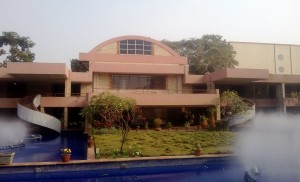24th January 2014 Mumbai, India
Plasma research by the Sabarmati
Fluorescent lamps; flat-panel displays; sterilisation devices for medical tools – what’s common among these items? They all have plasma in them! Plasma is the fourth state of matter; the others being solid, liquid, and gas. It is formed when a gas is heated to extremely high temperatures.
Recently, I visited the Institute for Plasma Research (IPR), located on the banks of the Sabarmati river, and conveniently placed between the cities of Ahmedabad and Gandhinagar in Gujarat. IPR is an autonomous institute under the Department of Atomic Energy (DAE) since 1995. Several research areas are being pursued at the IPR including large ultra high vacuum systems, laser induced florescence, nuclear detection techniques, and high-voltage and high-current pulsed power systems, to name a few. 
The IPR, one of the partners in the international ITER project, is currently building a steady state superconducting tokamak (SST-1). India is a partner country to this international effort and will be contributing roughly 10 % of the construction cost, mostly in kind. I met with Prof. Dhiraj Bora (Director) and Prof. R. Jha (Dean), who informed me that the IPR interacted with several labs in the European Union including the Culham Centre for Fusion Energy (CCFE) in Abingdon, UK, through the European Fusion Development Agreement (EFDA). Also, the IPR is contributing hardware and software as well as designing one of the component prototypes for the current largest fusion experiment in the world – the Joint European Torus (JET) located near Oxford, UK. ITER will be a scaled-up version of JET, and completed in 2019.
Several UK companies are involved in the construction of the ITER fusion project in France; in fact, the UK industry ranks third in the number of ITER contracts awarded. The Culham Centre for Fusion Energy is currently playing a major role in the measurement of the temperature and density of the plasma, Ion Cyclotron Resonance, and Neutral Beam heating systems.
The Facilitation Centre for Industrial Plasma Technologies (FCIPT) at the IPR facilitates the commercialisation of plasma processing technologies from the laboratory to the marketplace. The ongoing projects at the FCIPT have applications in textiles, biomedical waste disposal, space rockets, and energy recovery. The surface characterization laboratory at the FCIPT houses equipment such as scanning electron microscope and x-ray diffraction apparatus. The multi-disciplinary team of scientists and engineers at the FCIPT has expertise in plasma physics, plasma chemistry, metallurgy, material sciences, power electronics and instrumentation.
So, the next time you switch on either a fluorescent lamp or flat screen television, remember that there’s a collection of charged particles (plasma) at work!